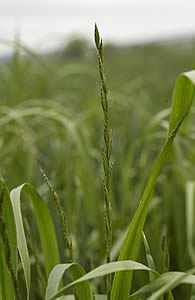| 2009-04-16
Winter cereal growers could benefit from changing some of their long-held beliefs about the best time to control one of the UK’s most competitive grass weeds.
 |
That is the message emerging from new rye-grass research by scientist Rocio Alarcon-Reverte in a project co-funded by HGCA and Syngenta and supervised by Rothamsted Research and the University of Reading.
According to Dr Stephen Moss of Rothamsted Research, many farmers delay spraying rye-grass in winter cereals because of a belief that it mainly germinates in spring. However the new research, conducted at five field sites over the last two years, found no evidence of a spring flush of Italian rye-grass in winter cereals, he points out.
Instead, while 81% of total emergence occurred in October and 13% in November and December across the five sites, just 6% occurred in January to April. Furthermore, emergence patterns were similar for all five sites in both years, despite big differences in total weed density of 4 - 200 rye-grass plants per square metre.
“We never saw any indication of a spring flush for rye-grass” says Dr Moss. “We are not saying that no emergence happens in the spring, simply that there is a lot less spring emergence than people generally think.
“We have seen fields where it is hard to find any rye-grass plants during the winter, but by June rye-grass heads are all too evident. Such situations are often blamed on spring emergence whereas, in reality, the vast majority of rye-grass plants are already there in winter, but you may have to grovel on your hands and knees to find them,” he adds. “We are talking here about emergence patterns in well established autumn sown crops. Rye-grass certainly can emerge in spring if land is cultivated, or on bare land.”
Assessing the practical consequences of the research, Dr Moss points to delayed autumn sowing as having the potential to greatly reduce rye-grass infestations, provided that all emerged rye-grass plants are effectively destroyed with glyphosate pre-drilling. Also, aim to achieve effective chemical control in the autumn, and consider basing control on both pre- and post-emergence herbicides, he notes.
Among the most effective pre- and post-emergence herbicides for rye-grass control in winter wheat, Dr Moss highlights prosulfocarb or flufenacet + pendimethalin and pinoxaden or mesosulfuron + iodosulfuron respectively. “Pre-emergence herbicides have a significant role to play in the control of rye-grass infestations, especially if they are resistant. Apply post-emergence herbicides in autumn at the earliest opportunity according to label recommendations and soil moisture status,” he adds.
Syngenta technical manager, Jason Tatnell, agrees that results underline the need to control rye-grass in autumn. It was precisely because high levels of control were achieved from autumn spraying when developing Defy (prosulfocarb) and Axial (pinoxaden) that Syngenta became involved in the project, he points out.
“The findings that rye-grass germinates mainly in the autumn will come as a surprise to many people,” says Mr Tatnell. “But we need to get that message across.
“Controlling in the autumn is both realistic and desirable, firstly because of better yield protection from early removal of weed competition, and secondly for resistance management – because smaller weeds are easier to kill.
“Earlier work by Rocio showed that levels of rye-grass resistance to Axial (pinoxaden) were far lower than for some alternative herbicides. Also, Axial performs well even in colder weather, which is a useful feature for autumn spraying. If you’ve used Axial in autumn, you can still follow this up with other herbicides, such a fop or a sulfonylurea, in spring – provided they’ve not already been used.
“By beginning programmes with a Defy mixture against rye-grass you’re creating a solid foundation against the weed. Usefully, both Defy and Axial can also be used in winter barley as well as winter wheat.”
 Dekalb Launches New Low Biomass Hybrid OSR Dekalb Launches New Low Biomass Hybrid OSR
 Unexpected Rust Now Appearing in Winter Wheat Unexpected Rust Now Appearing in Winter Wheat
 BCPC Highlights Confusion over EU Approvals of Organic Pesticides BCPC Highlights Confusion over EU Approvals of Organic Pesticides
|



